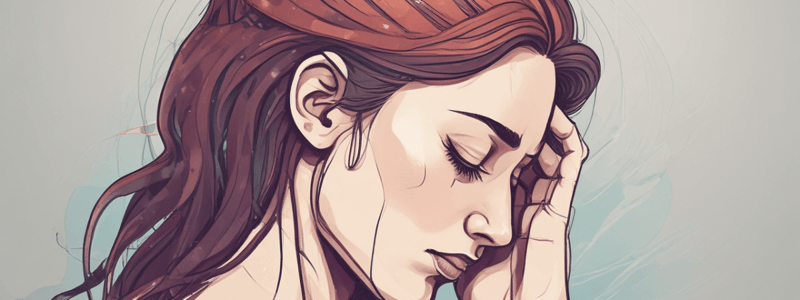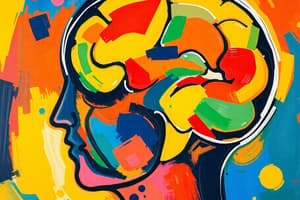Podcast
Questions and Answers
Cluster headaches are typically caused by another medical condition.
Cluster headaches are typically caused by another medical condition.
False (B)
Tension headaches are usually characterized by severe, throbbing pain on one side of the head.
Tension headaches are usually characterized by severe, throbbing pain on one side of the head.
False (B)
Diagnosis of headaches is based solely on physical exam.
Diagnosis of headaches is based solely on physical exam.
False (B)
Flashcards
Primary Headaches
Primary Headaches
Headaches not caused by another medical issue.
Migraine Symptoms
Migraine Symptoms
Severe throbbing pain on one side of the head, often with nausea and light sensitivity.
Tension Headache Cause
Tension Headache Cause
Muscle tension, stress, and poor posture often lead to tension headaches.
Study Notes
Definition and Classification
- A headache is a type of pain that occurs in the head or neck region
- Classified into two main categories:
- Primary headaches: not caused by another medical condition, examples include:
- Migraines
- Tension headaches
- Cluster headaches
- Secondary headaches: caused by another medical condition, examples include:
- Sinus headaches
- Allergies
- Infections
- Head trauma
- Primary headaches: not caused by another medical condition, examples include:
Causes and Triggers
- Migraines:
- Causes: genetics, hormonal changes, sensory stimuli
- Triggers: certain foods, stress, lack of sleep, hormonal changes
- Tension headaches:
- Causes: muscle tension, stress, poor posture
- Triggers: stress, fatigue, eye strain
- Cluster headaches:
- Causes: unknown, but linked to hypothalamus dysfunction
- Triggers: stress, certain foods, changes in sleep patterns
Symptoms
- Migraines:
- Severe, throbbing pain on one side of the head
- Nausea and vomiting
- Sensitivity to light and sound
- Tension headaches:
- Mild to moderate pain on both sides of the head
- Feeling of tightness or pressure
- Neck and shoulder tension
- Cluster headaches:
- Severe, one-sided pain around the eye
- Redness and tearing of the eye
- Sweating and flushing of the face
Diagnosis and Treatment
- Diagnosis: based on medical history, physical exam, and symptom description
- Treatment:
- Migraines: pain-relieving medications, preventative medications, lifestyle changes
- Tension headaches: over-the-counter pain medications, stress management, relaxation techniques
- Cluster headaches: oxygen therapy, pain-relieving medications, preventative medications
Definition and Classification
- Headaches are pains that occur in the head or neck region
- Headaches can be classified into two main categories: primary and secondary
Primary Headaches
- Not caused by another medical condition
- Examples of primary headaches include migraines, tension headaches, and cluster headaches
Secondary Headaches
- Caused by another medical condition
- Examples of secondary headaches include sinus headaches, allergies, infections, and head trauma
Causes and Triggers
Migraines
- Can be caused by genetics, hormonal changes, and sensory stimuli
- Triggers include certain foods, stress, lack of sleep, and hormonal changes
Tension Headaches
- Can be caused by muscle tension, stress, and poor posture
- Triggers include stress, fatigue, and eye strain
Cluster Headaches
- Cause is unknown, but linked to hypothalamus dysfunction
- Triggers include stress, certain foods, and changes in sleep patterns
Symptoms
Migraines
- Severe, throbbing pain on one side of the head
- Nausea and vomiting
- Sensitivity to light and sound
Tension Headaches
- Mild to moderate pain on both sides of the head
- Feeling of tightness or pressure
- Neck and shoulder tension
Cluster Headaches
- Severe, one-sided pain around the eye
- Redness and tearing of the eye
- Sweating and flushing of the face
Diagnosis and Treatment
- Diagnosis is based on medical history, physical exam, and symptom description
Migraines
- Treatment includes pain-relieving medications, preventative medications, and lifestyle changes
Tension Headaches
- Treatment includes over-the-counter pain medications, stress management, and relaxation techniques
Cluster Headaches
- Treatment includes oxygen therapy, pain-relieving medications, and preventative medications
Studying That Suits You
Use AI to generate personalized quizzes and flashcards to suit your learning preferences.




